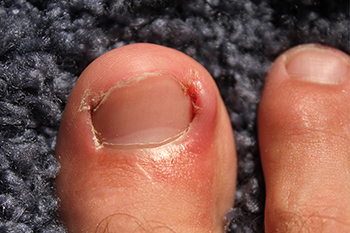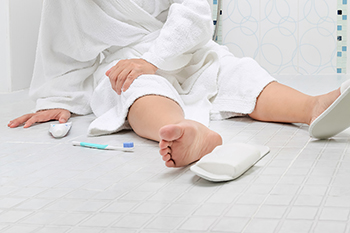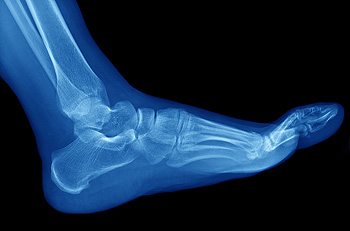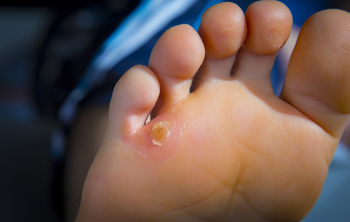Connect With Us
Blog
Items filtered by date: November 2023
Ingrown Toenails and Infection Control

Ingrown toenails, a common condition where the nail grows into the toe's skin, can lead to infections if not properly managed. They most often affect the big toe and can result from trauma, improper nail trimming, and wearing tight footwear. The skin surrounding the ingrown nail becomes red, swollen, and painful, and may produce pus, indicating an infection. Preventing infection in ingrown toenails involves proper foot hygiene and nail care. Toenails should be cut straight across, avoiding rounding the corners which can encourage the nail to grow into the skin. Wearing properly fitting shoes that provide enough space for the toes to wiggle freely in can also reduce the risk. If you have an ingrown toenail and suspect an infection, it is strongly suggested that you make an appointment with a podiatrist for an evaluation and treatment.
Ingrown toenails may initially present themselves as a minor discomfort, but they may progress into an infection in the skin without proper treatment. For more information about ingrown toenails, contact one of our podiatrists of Foot and Ankle Center. Our doctors can provide the care you need to keep you pain-free and on your feet.
Ingrown Toenails
Ingrown toenails are caused when the corner or side of a toenail grows into the soft flesh surrounding it. They often result in redness, swelling, pain, and in some cases, infection. This condition typically affects the big toe and may recur if it is not treated properly.
Causes
- Improper toenail trimming
- Genetics
- Improper shoe fitting
- Injury from pedicures or nail picking
- Abnormal gait
- Poor hygiene
You are more likely to develop an ingrown toenail if you are obese, have diabetes, arthritis, or have any fungal infection in your nails. Additionally, people who have foot or toe deformities are at a higher risk of developing an ingrown toenail.
Symptoms
Some symptoms of ingrown toenails are redness, swelling, and pain. In rare cases, there may be a yellowish drainage coming from the nail.
Treatment
Ignoring an ingrown toenail can have serious complications. Infections of the nail border can progress to a deeper soft-tissue infection, which can then turn into a bone infection. You should always speak with your podiatrist if you suspect you have an ingrown toenail, especially if you have diabetes or poor circulation.
If you have any questions, please feel free to contact our office located in Egg Harbor Township, NJ . We offer the newest diagnostic and treatment technologies for all your foot care needs.
Effective Fall Prevention Strategies for the Home

Preventing falls at home is essential for maintaining safety, especially for seniors or those with mobility challenges. You can take several steps to create a safer living environment. Begin by evaluating your home for potential hazards, paying close attention to loose rugs, clutter, and uneven surfaces. Ensure that walkways are clear, and keep frequently used items within easy reach. It is helpful to install handrails and grab bars in critical areas such as bathrooms and staircases that can provide essential support. Having adequate lighting is important so make sure that rooms and hallways are well-lit, with light switches easily accessible. Consider using non-slip mats in the bathroom and kitchen to reduce the risk of slipping. Furniture arrangement also plays a role, and it is beneficial to have it arranged in a style that can create clear pathways and ensure stability. Wearing supportive footwear with non-slip soles is essential, as it can greatly reduce the risk of falls. Additionally, staying physically active and maintaining muscle strength can improve balance and coordination, making falls less likely. Falling can greatly impact the feet, and it is suggested that you visit a podiatrist who can help you implement successful fall prevention strategies.
Preventing falls among the elderly is very important. If you are older and have fallen or fear that you are prone to falling, consult with one of our podiatrists from Foot and Ankle Center. Our doctors will assess your condition and provide you with quality advice and care.
Every 11 seconds, an elderly American is being treated in an emergency room for a fall related injury. Falls are the leading cause of head and hip injuries for those 65 and older. Due to decreases in strength, balance, senses, and lack of awareness, elderly persons are very susceptible to falling. Thankfully, there are a number of things older persons can do to prevent falls.
How to Prevent Falls
Some effective methods that older persons can do to prevent falls include:
- Enrolling in strength and balance exercise program to increase balance and strength
- Periodically having your sight and hearing checked
- Discuss any medications you have with a doctor to see if it increases the risk of falling
- Clearing the house of falling hazards and installing devices like grab bars and railings
- Utilizing a walker or cane
- Wearing shoes that provide good support and cushioning
- Talking to family members about falling and increasing awareness
Falling can be a traumatic and embarrassing experience for elderly persons; this can make them less willing to leave the house, and less willing to talk to someone about their fears of falling. Doing such things, however, will increase the likelihood of tripping or losing one’s balance. Knowing the causes of falling and how to prevent them is the best way to mitigate the risk of serious injury.
If you have any questions, please feel free to contact our office located in Egg Harbor Township, NJ . We offer the newest diagnostic and treatment technologies for all your foot care needs.
Causes and Symptoms of Foot Stress Fractures

Stress fractures, those tiny cracks in the bones of the feet, are a common concern for athletes, dancers, and anyone who spends a significant amount of time on their feet. These fractures are usually a result of repetitive stress and overuse, rather than sudden trauma. One primary cause of stress fractures is overexertion, often seen in athletes who increase their training intensity too quickly. Wearing Improper footwear or a sudden change in physical activity can also put undue stress on the bones. Inadequate nutrition and underlying conditions such as osteoporosis may weaken bones, making them more susceptible to fractures. Symptoms of a stress fracture typically include localized pain, swelling, and tenderness in the affected area. The pain usually worsens with activity and eases with rest. Left untreated, stress fractures can progress to chronic pain and complications, so early intervention is essential. Understanding the causes and recognizing these symptoms allows for prompt diagnosis and proper care, reducing the risk of more severe injuries and ensuring a quicker return to an active, pain-free lifestyle. If you have developed a foot stress fracture, it is suggested that you visit a podiatrist as quickly as possible who can effectively treat this condition.
Activities where too much pressure is put on the feet can cause stress fractures. To learn more, contact one of our podiatrists from Foot and Ankle Center. Our doctors can provide the care you need to keep your pain free and on your feet.
Dealing with Stress Fractures of the Foot and Ankle
Stress fractures occur in the foot and ankle when muscles in these areas weaken from too much or too little use. The feet and ankles then lose support when walking or running from the impact of the ground. Since there is no protection, the bones receive the full impact of each step. Stress on the feet can cause cracks to form in the bones, thus creating stress fractures.
What Are Stress Fractures?
Stress fractures occur frequently in individuals whose daily activities cause great impact on the feet and ankles. Stress factors are most common among:
- Runners
- People affected with Osteoporosis
- Tennis or basketball players
- Gymnasts
- High impact workouts
Symptoms
Pain from the fractures occur in the area of the fractures and can be constant or intermittent. It will often cause sharp or dull pain with swelling and tenderness. Engaging in any kind of activity which involves high impact will aggravate pain.
If you have any questions please feel free to contact our office located in Egg Harbor Township, NJ . We offer the newest diagnostic and treatment technologies for all your foot and ankle needs.
Get Professional Care for a Broken Foot or Ankle
Surgery May Relieve Painful Corns

Corns on the feet are most commonly caused by excessive pressure on the toe or bottom of the foot from wearing tight or ill-fitting shoes. When painful corns on your feet become unbearable and conservative treatments no longer work, surgery is a viable option. Corns, known medically as heloma, can become excruciating, making even the simplest daily activities a painful ordeal. The surgical procedure involves making a small incision over the affected toe to access the corn. The foot doctor removes the corn, repairs any tendon that may be involved, and closes the incision. Various numbing options, including general anesthesia, a spinal block, or local anesthesia with sedation, are offered based on the severity of the procedure. Surgery for painful corns addresses the root causes of discomfort and can provide a permanent solution. If persistent corn-related pain affects your life, it is suggested that you make an appointment with a podiatrist. This foot doctor can assess the need for surgery or offer other treatment options as needed.
If you have any concerns regarding your feet and ankles, contact one of our podiatrists of Foot and Ankle Center. Our doctors will treat your foot and ankle needs.
Corns: What Are They? and How Do You Get Rid of Them?
Corns can be described as areas of the skin that have thickened to the point of becoming painful or irritating. They are often layers and layers of the skin that have become dry and rough, and are normally smaller than calluses.
Ways to Prevent Corns
There are many ways to get rid of painful corns such as wearing:
- Well-fitting socks
- Comfortable shoes that are not tight around your foot
- Shoes that offer support
Treating Corns
Treatment of corns involves removing the dead skin that has built up in the specific area of the foot. Consult with Our doctors to determine the best treatment option for your case of corns.
If you have any questions please feel free to contact our office located in Egg Harbor Township, NJ . We offer the newest diagnostic and treatment technologies for all your foot and ankle needs.

